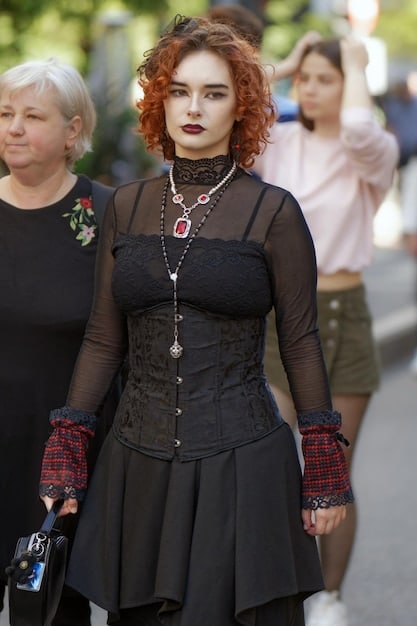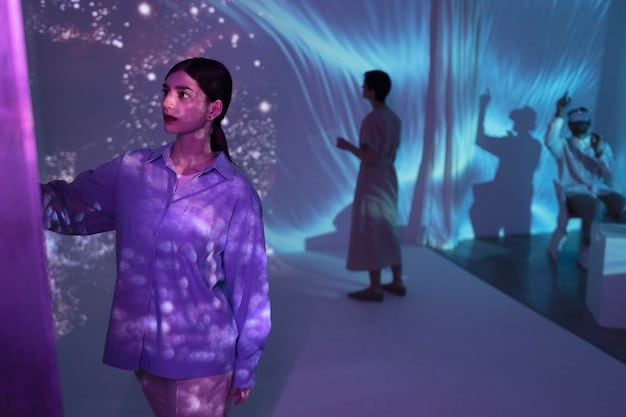Goth Subculture in the US: Evolution, Music, & Fashion (2025)

The ‘Goth’ subculture in the US is a multifaceted movement centered around dark aesthetics, introspective themes, and a unique blend of music, fashion, and philosophy, which continues to evolve and adapt in 2025.
The ‘Goth’ subculture in the US: Exploring the Evolution of Music, Fashion, and Philosophy in 2025 remains a vibrant and evolving tapestry, woven with threads of music, fashion, literature, and philosophy. How will it adapt and thrive in the coming years?
The Origins and Evolution of Goth in America
Goth, as a subculture, emerged in the late 1970s and early 1980s in the UK, but its influence quickly spread across the Atlantic to the United States. Its roots lie in the post-punk movement, drawing inspiration from bands like Bauhaus, Siouxsie and the Banshees, and The Cure.
In the US, the Goth subculture found fertile ground in urban centers and college towns. The early American Goth scene was heavily influenced by the British pioneers, but it soon began to develop its own distinct identity. This included embracing elements of industrial music, incorporating American horror and gothic literature, and adopting a more theatrical and diverse fashion sense.
Key Musical Influences
The musical landscape of the Goth subculture is vast and varied, but several genres and bands have played a pivotal role in shaping its sound:
- Post-Punk: Bands like Joy Division and The Sisters of Mercy laid the foundation for the dark, atmospheric sound that defines Goth music.
- Gothic Rock: The Mission and Fields of the Nephilim further refined the genre, blending post-punk with elements of hard rock and gothic literature.
- Industrial: Acts like Nine Inch Nails and Ministry brought a harsher, more electronic edge to the subculture, influencing the sound of many Goth bands.
- Darkwave: This genre combines elements of new wave, synth-pop, and Goth, creating a lush, atmospheric soundscape embraced by many Goths.
The American Goth scene has also produced its own influential bands, such as Christian Death and Rozz Williams, who infused the subculture with a uniquely American sensibility.

The evolution of Goth music continues to be driven by innovation and experimentation, with new bands and genres emerging to push the boundaries of the subculture’s sonic landscape.
Fashion: The Dark Aesthetic
Fashion is an integral part of the Goth subculture, serving as a visual expression of its dark aesthetic and philosophical themes. From Victorian-inspired attire to modern interpretations of gothic style, the fashion of the Goth subculture is diverse and constantly evolving.
In the early days, Goth fashion drew heavily from punk and new wave, incorporating elements like ripped clothing, safety pins, and dark makeup. As the subculture developed, it began to embrace more romantic and theatrical elements, drawing inspiration from Victorian and Edwardian fashion.
Key Elements of Goth Fashion
Many distinct elements define Goth Fashion:
- Dark Colors: Black is the predominant color, but shades of deep purple, red, and green are also common.
- Lace and Velvet: These fabrics add a touch of elegance and sophistication to Goth attire, evoking a sense of romance and mystery.
- Corsets and Bustiers: These garments emphasize the figure, adding a touch of sensuality to the dark aesthetic.
- Heavy Makeup: Pale foundation, dark eyeliner, and lipstick are essential elements of Goth makeup, creating a dramatic and otherworldly look.
Today, Goth fashion continues to evolve, incorporating elements of cyberpunk, industrial, and fetish wear. Many Goths also embrace DIY fashion, creating their own unique and personalized looks.
The fashion of the Goth subculture is not merely about aesthetics; it’s a form of self-expression, a way for individuals to express their individuality and connect with others who share their dark sensibilities.
Philosophy and Intellectual Themes
Beyond the music and fashion, the Goth subculture also encompasses a range of philosophical and intellectual themes. These themes often explore the darker aspects of human existence, such as mortality, alienation, and the search for meaning in a seemingly meaningless world.
Goths often find inspiration in gothic literature, art, and film, which provide a rich source of imagery and ideas. Authors like Edgar Allan Poe, H.P. Lovecraft, and Anne Rice are popular among Goths, as are films like “The Cabinet of Dr. Caligari” and “Nosferatu.”
Key Philosophical Themes
- Existentialism: Goths often grapple with questions of existence, identity, and purpose, finding solace in existentialist philosophy.
- Romanticism: The Romantic movement of the 19th century, with its emphasis on emotion, imagination, and the individual, has also influenced the Goth subculture.
- Anti-conformity: Goths often reject mainstream values and norms, embracing individuality and self-expression.
- Aestheticism: The pursuit of beauty and the appreciation of art are central to the Goth subculture.
These philosophical and intellectual themes provide a framework for understanding the Goth subculture. It’s a space to connect with others who share their interests and values.
The Digital Age and the Future of Goth (2025)
The digital age has had a profound impact on the Goth subculture, transforming the way Goths connect, share information, and express themselves. Social media platforms, online forums, and streaming services have created new opportunities for Goths to connect with each other, regardless of geographical location.
In 2025, the digital age will likely continue to shape the Goth subculture. Virtual reality (VR) and augmented reality (AR) technologies create immersive experiences that could revolutionize the way Goths interact with music, fashion, and art. Online platforms and virtual spaces offer new avenues for self-expression and community building.
Predictions for the Future
- Increased Online Interaction: The internet will become an even more important space for Goths to connect, share ideas, and form communities.
- VR and AR Experiences: These technologies will be used to create immersive Goth events, concerts, and fashion shows.
- DIY Culture: The DIY ethos of the Goth subculture will continue to thrive, with Goths using online resources to create their own music, fashion, and art.
- Globalized Community: The Goth subculture will become even more globalized, with Goths from all over the world connecting and collaborating online.
The digital age presents both opportunities and challenges for the Goth subculture. Retaining its unique identity while embracing new technologies will be key.

Goth Subculture in Different Regions of the US
Although there exist unifying elements, the Goth subculture presents distinct regional variations throughout the expanses of the United States. Regions such as Southern California will give rise to warmer variants of the Goth attire, as well as a bigger emphasis on the Deathrock strand of the subculture. Meanwhile, you will find a more uniform take on the matter in cities like New York or Chicago, with the Industrial elements and Gothic Rock greatly valued.
A few of the regional variations are:
California
- Emphasis on Deathrock: California has maintained a strong Deathrock strand since the early eighties.
- Warmer Attire: The weather allows for less cumbersome attire.
New York
- Greater focus on Industrial: A more uniform take on Goth.
- Greater influence of Gothic Rock: One of the mainstays of the subculture.
While there many exist distinct variations between the different Goth branches prevalent in different areas of the US, the spirit of the subculture persists.
Challenges and Misconceptions
The Goth subculture has faced its share of challenges and misconceptions over the years. Stereotypes and prejudices often paint Goths as morbid, depressed, or even dangerous. These misconceptions often stem from a lack of understanding of the subculture’s values and motivations.
One of the biggest misconceptions about Goths is that they are all Satanists or involved in the occult. While some Goths may be interested in these topics, they do not represent the entire subculture. The Goth subculture encompasses a wide range of beliefs and interests, and it is unfair to stereotype all Goths based on the actions of a few.
Overcoming Misconceptions
- Education: Educating the public about the Goth subculture can help to dispel misconceptions and promote understanding.
- Community Outreach: Goth communities can reach out to the wider community to share their values and experiences.
- Positive Representation: Promoting positive representations of Goths in the media can help to challenge stereotypes and prejudices.
By addressing these challenges and misconceptions, the Goth subculture can continue to thrive and evolve, enriching the cultural landscape of the United States.
| Key Point | Brief Description |
|---|---|
| 🎶 Musical Roots | Evolved from post-punk, incorporating genres like gothic rock, industrial, and darkwave. |
| 🖤 Fashion Aesthetic | Dark colors, lace, velvet, corsets, and dramatic makeup define the Goth look. |
| 🤔 Philosophical Themes | Explores existentialism, romanticism, anti-conformity, and aestheticism. |
| 🌐 Digital Impact | The internet and VR/AR technologies are shaping the future of online Goth communities. |
[FAQ]
Frequently Asked Questions about the Goth Subculture
▼
The Goth subculture originated in the late 1970s and early 1980s in the UK. It emerged from the post-punk movement. Initial musical influences include Bauhaus, Siouxsie and the Banshees, and The Cure.
▼
Key elements of Goth fashion include dark colors (especially black), lace and velvet fabrics, corsets, and heavy makeup (pale foundation, dark eyeliner, and lipstick). These contribute to a dark and theatrical aesthetic.
▼
Goths commonly explore themes such as existentialism, romanticism, anti-conformity, and aestheticism. They may find inspiration in gothic literature, art, and film, like the authors H.P. Lovecraft and Edgar Allan Poe.
▼
The internet has enabled goths to connect globally through social media, online forums, and streaming services. Expect developments with virtual reality to enhance virtual experiences for concerts and social meetups.
▼
Common misconceptions are that all goths are morbid, depressed, or satanists. Gothic culture is diverse and contains a vast amount of beliefs and interests. Stereotyping and prejudices contribute to these false notions.
Conclusion
The Goth subculture in the US maintains its unique presence. From its history rooted in post-punk to its current adaptation to the digital age, Goth serves as a way for those who embrace the counterculture and its various forms of expressions.





